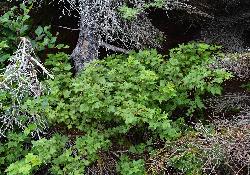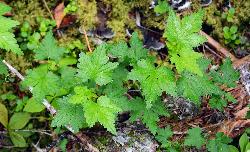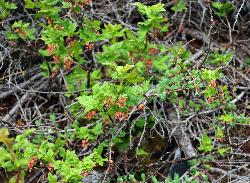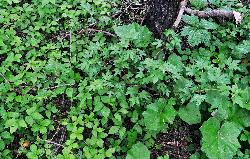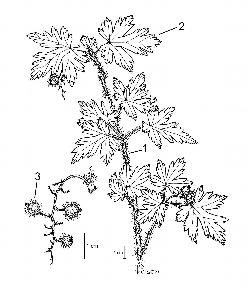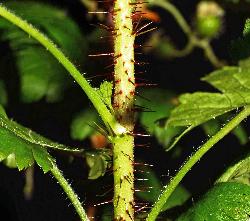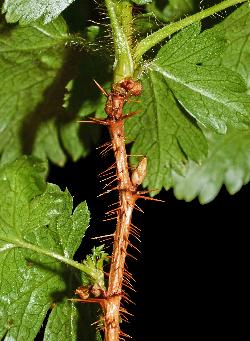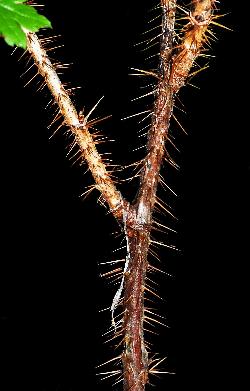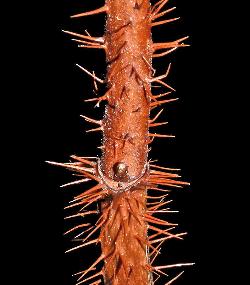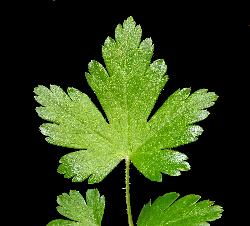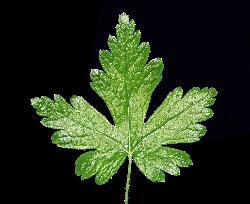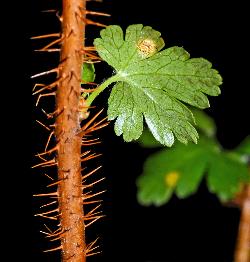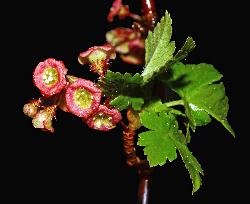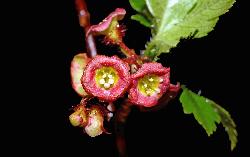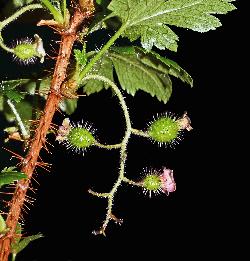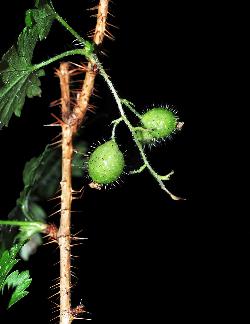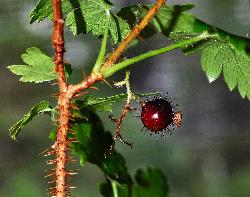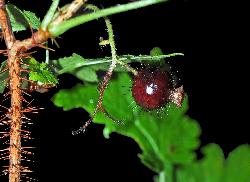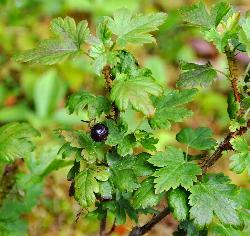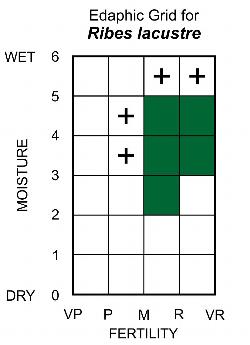Fr: gadellier lacustre
IA: kakuminakashi, kakumin (the fruit)
Grossulariaceae - Currant Family
Note: Numbers provided in square brackets in the text refer to the images presented above; image numbers are displayed to the lower left of each image.
General: An erect, straggling, or prostrate deciduous shrub, to 1.5 m tall, with very prickly branches and stout stipular spines [1–5]. There is disagreement in the literature as to whether or not Ribes lacustre is rhizomatous, but prostrate branches that touch the ground can form adventitious roots and develop into new plants (Carey 1999). Bristly black currant berries are edible but somewhat unpalatable; the plants provide cover and food for a variety of birds and small mammals. All currant species, including bristly black currant, are alternate hosts for white pine blister rust (Cronartium ribicola F.C. Fisch.), a serious disease of Pinus strobus and other 5-needled pine species.
Key Features: (numbers 1–3 refer to the illustration [6])
1. Stems are densely armed with numerous prickles along the internodes, as well as 1–3 stipular spines that subtend the leaf or leaf scar.
2. Leaves are deeply 5–7-lobed, incised more than halfway to the base; the central lobe is widest near the middle and narrowed at the base; margins are deeply toothed and the base is divergent to somewhat cordate.
3. Berries are dark purplish-black, bristly, and borne in drooping clusters.
Stems/twigs: Young green stems are puberulent and armed with numerous stiff reddish-brown internodal prickles and stipular spines at the nodes. The literature indicates that only 1–3 stipular spines occur at the nodes, but stems of Ribes lacustre examined in Newfoundland had up to 11 "spines" subtending new shoots and leaf scars [7–11]; some of these may be internodal prickles clustered beneath the stipular spines. Woody twigs are greyish-brown to warm brown, lustrous when young, and also have numerous internodal prickles and several stouter stipular spines, 3–12 mm long, which subtend the leaves or leaf scars [10–11]; older stems are dull reddish-brown and very prickly. Buds are lanceoloid to ovoid, pointed, and have several imbricate bud scales. Leaf scars are narrow, broadly U-shaped, and have 3 bundle trace scars [11].
Leaves: Alternate, simple, palmately lobed, and petiolate; petioles are 2.5–5.5 cm long, somewhat wider at the base, finely short-pubescent, and bear numerous long white stipitate-glandular hairs along the petiole [12]. The leaf blades are 4–8 cm long and wide, and deeply divided into 5–7 obovate to rhomboidal lobes [13–15]. The central lobe is widest near the middle and narrows noticeably towards the base; the central and upper pair of lobes are larger than the lower 1–2 pairs, which are progressively smaller towards the base; sinuses between the lobes are very deep and narrow. Margins of the lobes are incised into rounded blunt-tipped teeth. The blade is dark green above and mainly glabrous; the lower surface is slightly paler, glossy, and bears scattered stipitate glandular hairs [12, 15]. Leaf bases are divergent to somewhat cordate, apices are acute.
Leaves infected with white pine blister rust have orange swollen patches from which the pustules develop on the lower leaf surface or stem [16], these represent 1 of the 5 stages of the fungus, Cronartium ribicola; of which 3 stages develop in Ribes. Orange urediniospores emerge from the pustules and can infect other Ribes plants. Teliospores are the next stage to develop, forming brown rusty patches on the leaves. The final stage on Ribes sees the development and release of basidiospores, which are transferred by wind to pine trees, restarting the disease cycle (Maloy 2016).
Flowers: Bisexual, in spreading to drooping racemes, 3–4 cm long, with 5–18 flowers, and emerging from lateral buds on woody stems; the axis of the inflorescence and pedicels are finely hairy and also bear short glandular hairs; while the outer surface of the shallow saucer-shaped hypanthium is densely covered in long reddish stipitate-glandular bristles [17–18]. Flowers are about 6 mm across, borne on jointed pedicels 2-10 mm long, each subtended by a narrow lanceolate bract, 2–4 mm long. Flowers have a petaloid calyx with 5 broad, yellowish-green, pinkish, or salmon-coloured overlapping lobes borne at the rim of the hypanthium; the 5 smaller petals are fan-shaped (flabelliform), pinkish to salmon-coloured, and alternate with the calyx lobes [19]. The inner surface of the hypanthium is flat and covered by a yellow to pinkish nectar disk. The 5 stamens are slightly longer than the perianth, have yellow filaments, creamy white anthers, and are attached (adnate) to the edge of the disk, opposite the calyx lobes [19]. The ovary is inferior and has 2 styles connate at the base. Flowers bloom in early summer. All native Ribes species in our area can self-fertilize, but are also pollinated by insects, primarily bumblebees (Bombus spp.) and honeybees (Apis spp.), as well as other bees and flies (entomophily) (Bratsch and Williams 2009).
Fruit: In drooping clusters of globose purplish-black berries, each 9–12 mm in diameter (technically, the fruit is a false berry, derived from an inferior ovary). Berries are covered in fine gland-tipped bristles and mature from green [20–21] to red to dark purplish-black [22–24]. After fruit set, the shrivelled brown perianth is persistent at the end of the developing fruit. The fruits separate at the joint of the pedicel, just below the ovary, leaving most of the pedicel attached to the fruiting axis. Berries are edible, but have a somewhat unpleasant taste. Dispersal is by a variety of mammals and birds, which eat the fruit (endozoochory).
Ecology and Habitat: Bristly black currant is most frequently found in moist to wet nutrient-rich forests, swamps, and along stream banks. It is a shade-tolerant species that can occur in low abundance in the forest understorey, but grows better in open and early successional stage forests. It also grows well on limestone gravels.
Edaphic Grid: See image [25]: the Edaphic Grid for Ribes lacustre.
Forest Types: Bristly black currant has been recorded, usually in small patches, in the following forest types:
Abietum caricetum (Carex-Balsam Fir Forest Subassociation)
Abietum rubetosum (Rubus-Balsam Fir Forest Subassociation)
Abietum sphagnetosum (Sphagnum-Balsam Fir Forest Subassociation)
Abietum taxetosum (Taxus-Balsam Fir Forest Subassociation)
Aceretum galietosum (Galium-Mountain Maple Thicket Subassociation)
Alneto-Piceetum (Alder-Black Spruce Swamp Association)
Betuletum rubetosum (Rubus-White Birch Forest Subassociation)
Betuletum typicum (White Birch-Mountain Alder Forest Subassociation)
Carici-Piceetum (Carex-Black Spruce Fen Subassociation)
Osmundo-Piceetum (Osmunda-Black Spruce Fen Subassociation)
Succession: Bristly black currant grows in open to partially shaded habitats, where the stems may be reclining. It usually occurs in low frequency and abundance less than 5% even after disturbance. Reproduction is primarily by seed, but it can spread considerably through adventitious roots. Branches in contact with moist soil can also produce adventitious roots that spread rapidly. The seeds can persist in the soil for long periods and germinate over time. Seedling establishment is better where the organic layer is scarified. Bristly black currant can survive clearcutting, but it does not proliferate rapidly in response to light, and its abundance in clearcuts are in the same order as mature forests, but height growth is often better. Its response to fire is similar, but intense fires that remove the humus layer destroy the root system and the buried seed source, requiring longer periods for recruitment by animals from external sources (Carey 1995).
Distribution: Ribes lacustre is a north-temperate and boreal species that occurs throughout central and western Newfoundland, but is absent from the Avalon Peninsula and south coast; it extends north to the Churchill River basin in central Labrador (Rouleau and Lamoureux 1992, Scoggan 1978). Its range in North America extends from Newfoundland and Labrador west to Alaska. In Canada, it is present in most provinces, except for Nunavut. In the United States, it occurs inconsistently from Maine west to northern California, but is absent from most of the prairie States. In the east, it extends southwest from Maine to Virginia (USDA, NRCS 2016).
Similar Species: Currants and gooseberries are both classified as species of the same genus (Ribes), but currants have several flowers arranged in long racemes, their flowers are borne on jointed pedicels, and the hypanthium is open and saucer-shaped; gooseberries have 1–3 flowers borne on unjointed pedicels in leaf axils, and their flowers have a short tubular hypanthium. Skunk currant (Ribes glandulosum Grauer) is the only other native currant in our province that has bristly berries, but skunk currant berries occur in ascending to spreading clusters. The leaves of skunk currant have a deeply cordate base and wider lobes that are less deeply divided and wider to only slightly narrowed at the base.


